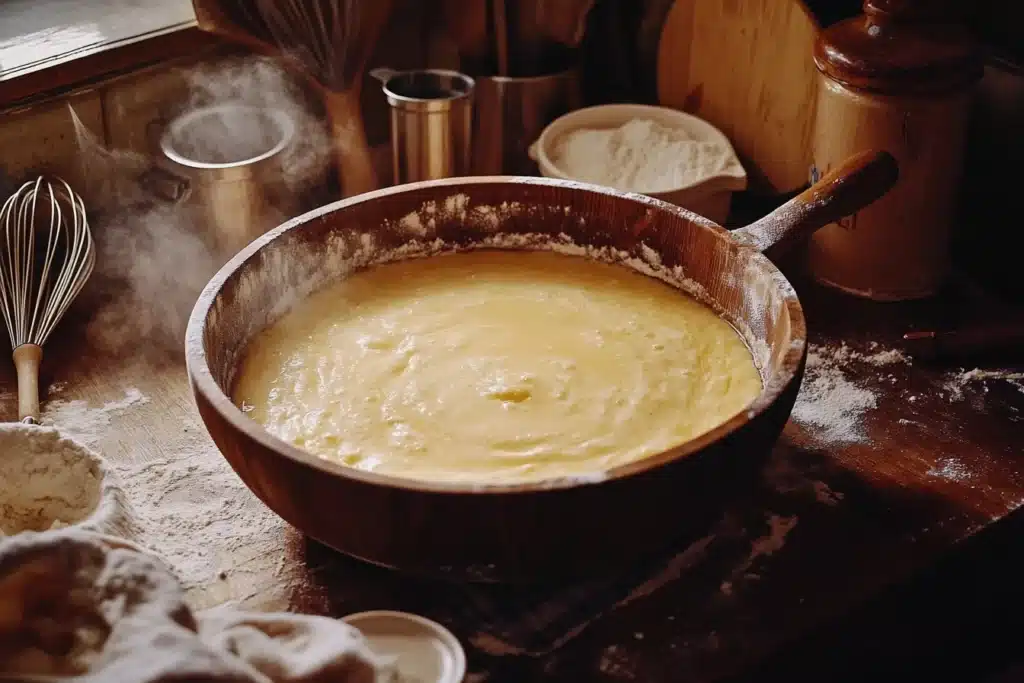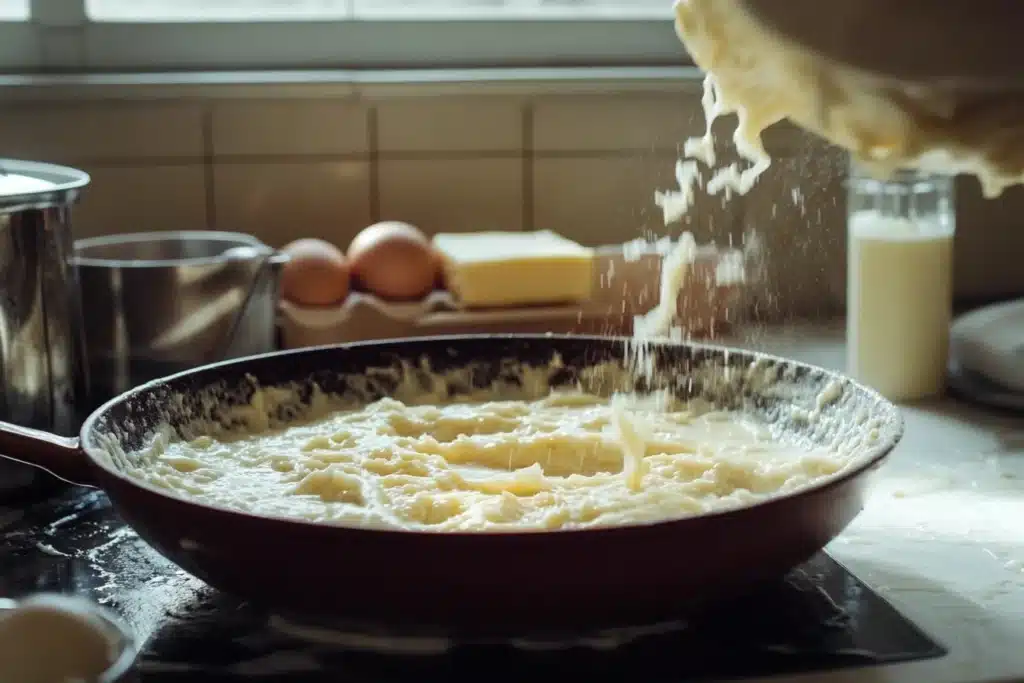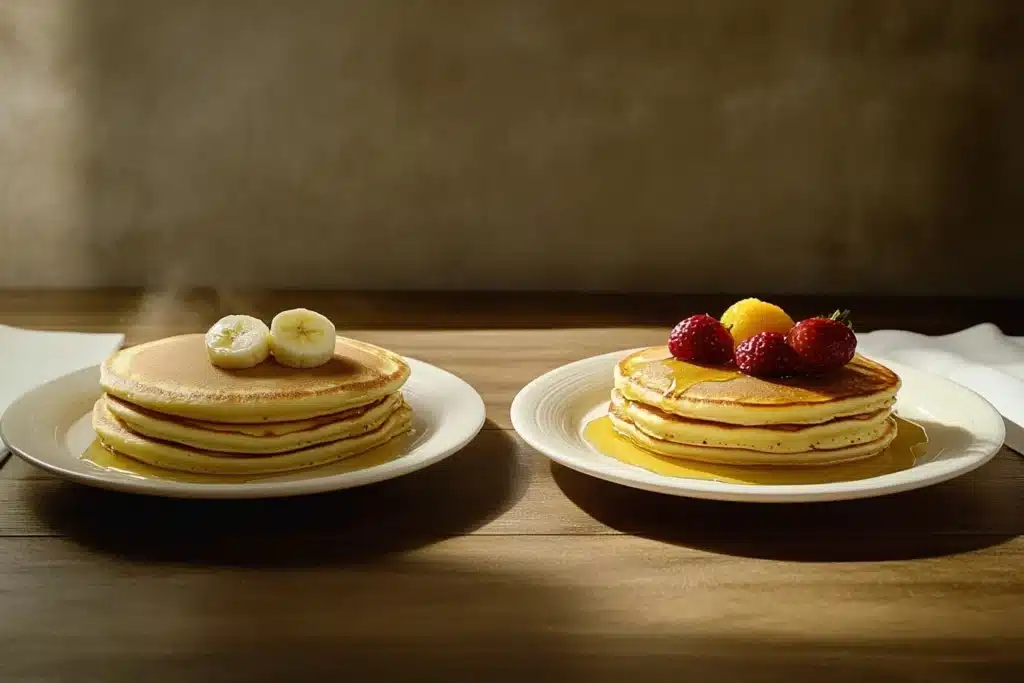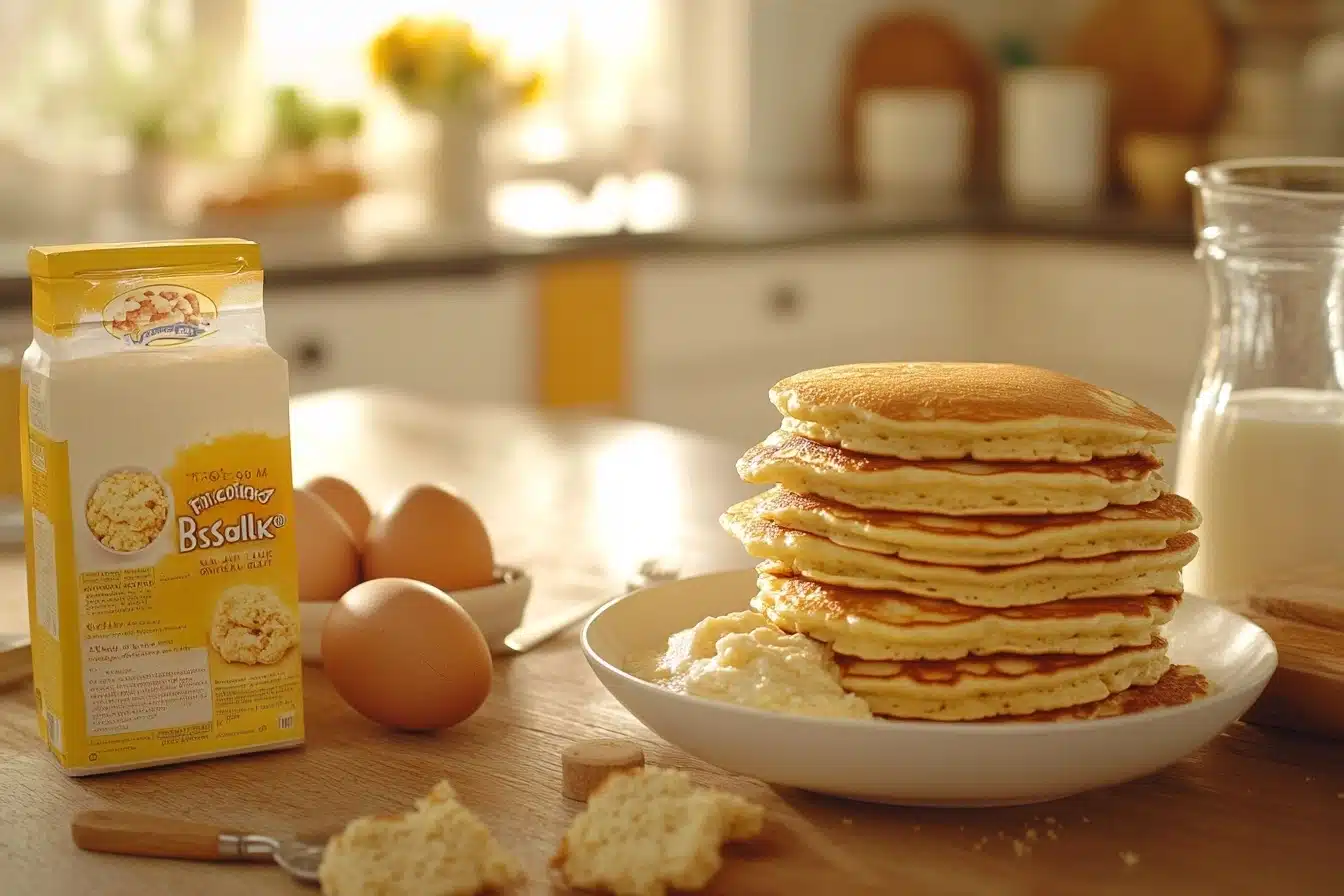Have you ever wondered if Bisquick pancakes taste better when made with water or milk? This seemingly simple choice can have a big impact on texture, flavor, and even nutrition. Whether you’re whipping up breakfast for the family or preparing a quick snack, knowing which liquid to use with Bisquick mix can help you achieve the perfect results every time. In this guide, we’ll break down the differences, compare the effects, and provide practical tips to help you decide what’s best for your next batch of pancakes, biscuits, or waffles.
Introduction
Bisquick, a beloved pantry staple, has been a go-to for quick and delicious meals for decades. Whether you’re craving fluffy pancakes, tender biscuits, or crispy waffles, this versatile baking mix has you covered. With a base of flour, shortening, salt, and leavening agents, Bisquick mix simplifies meal prep, letting you create everything from breakfast favorites to savory dinner recipes in no time.
The beauty of Bisquick lies in its adaptability. You can tweak recipes by adding fruits, cheeses, or herbs to enhance flavors. But have you ever considered how the liquid you use—water or milk—affects the final dish? This seemingly simple choice can make a huge difference in texture, taste, and overall satisfaction.
Your choice of liquid not only impacts the outcome of your recipe but also speaks to personal preferences and dietary needs. While water is convenient and calorie-free, milk adds richness and depth of flavor. Throughout this guide, we’ll explore how each option performs, helping you make the best decision for your next Bisquick creation.
For a comprehensive resource on creating the perfect Bisquick biscuits, including additional tips, recipe variations, and creative ideas, check out The Ultimate Guide to Perfect Bisquick Biscuits.
Understanding Bisquick Mix and Its Liquid Options
Bisquick is a renowned all-in-one baking mix, celebrated for its convenience and adaptability. Made from a carefully balanced combination of flour, hydrogenated oil, salt, and baking powder, Bisquick mix with water or Bisquick mix with milk works seamlessly across recipes, from pancakes to dumplings.
What makes Bisquick so versatile is its pre-measured ingredients, which save time and eliminate the hassle of gathering multiple baking staples. Instead of starting from scratch, you can trust Bisquick to provide a reliable and consistent base for various dishes, whether sweet or savory.
Versatility of Bisquick: More Than Pancakes and Waffles
Though often associated with breakfast classics like pancakes and waffles, Bisquick mix with water or milk can be transformed into a wide range of dishes. It serves as an excellent base for pizza crusts, casseroles, or even coatings for fried chicken. This adaptability makes Bisquick a must-have pantry item for quick meal solutions without compromising quality.
The choice of liquid—whether you’re using water in Bisquick or using milk in Bisquick—plays a significant role in determining the outcome. By understanding these differences, you can elevate your Bisquick creations to match your preferences and needs.
Role of Liquids in Bisquick Recipes
How Liquids Like Water or Milk Affect Baking
Liquids are the unsung heroes in baking, performing essential functions like hydrating dry ingredients, activating leavening agents, and binding components together. In Bisquick recipes, the liquid you choose directly influences the texture, taste, and moisture content of your dish.
- Water in Bisquick recipes is a neutral option, perfect for simplicity and calorie-conscious cooking. Its lack of flavor allows other ingredients, like syrups or spices, to shine.
- Milk in Bisquick recipes, on the other hand, adds creaminess and subtle sweetness while promoting browning for visually appealing results.
Impact of Water vs. Milk on Specific Dishes
When comparing water vs milk in Bisquick recipes, water creates lighter textures and less flavor-rich outcomes, ideal for quick, no-fuss meals. Milk, however, enhances both texture and taste, resulting in fluffier pancakes and golden, tender biscuits.
Understanding how these liquids work allows you to customize your Bisquick dishes, ensuring they turn out just the way you like them every time.
Using Water in Bisquick Recipes
When using water in Bisquick recipes, understanding its impact on texture, flavor, and nutrition is essential. Water is often chosen for its simplicity, availability, and calorie-free profile, but does it truly match the results you’d get with milk?
Effects on Texture and Consistency
Water creates a batter or dough that is thinner and lighter. This can be advantageous for those who prefer a leaner texture in pancakes and waffles. However, since water lacks the fat and proteins present in milk, it contributes less to the structure of baked goods.
Pancakes made with water may turn out slightly less fluffy, while biscuits might feel drier and more crumbly. Recipes using water often don’t hold their shape as well, especially in comparison to those made with milk or other richer liquids.

Impact on Flavor Profile
Water’s neutrality is both a strength and a drawback. It doesn’t interfere with the flavors of other ingredients, which can be ideal for dishes where syrups, spices, or toppings dominate. However, it also means that dishes like pancakes or biscuits might lack the creamy richness that milk offers. This can leave the final product tasting a bit plain when subtle flavors are at play.
Nutritional Considerations
One of the most significant advantages of using water in Bisquick recipes is its zero-calorie nature. This makes it a great option for lighter dishes or for those aiming to reduce their calorie intake. Water is also allergen-free, making it suitable for people with lactose intolerance or milk allergies.
Despite these benefits, water might not deliver the same level of satisfaction as milk in some recipes. For simpler needs or dietary reasons, however, it remains a practical and healthy choice.
Water, being calorie-free, is a healthier choice for those watching their intake or managing dietary restrictions. If you’re curious about the broader health benefits of cutting calories or substituting milk, resources like Healthline provide valuable insights into making smarter dietary choices.
Comparison of Water vs. Milk in Bisquick Recipes
| Aspect | Water | Milk |
|---|---|---|
| Texture | Thinner, lighter, less fluffy | Creamier, cohesive, fluffier |
| Flavor | Neutral, may taste bland | Richer, adds subtle sweetness |
| Nutritional Profile | Zero calories, allergen-free | Higher calories, adds calcium and protein |
| Best For | Light recipes, dietary restrictions | Rich, indulgent recipes |
Water offers convenience and health benefits, but milk brings richness and structure that elevates most Bisquick dishes. Ultimately, the choice depends on your needs and the results you’re aiming for.
Using Milk in Bisquick Recipes
Milk is the classic choice for Bisquick recipes, beloved for the richness and depth it adds. From pancakes to biscuits, incorporating milk into the mix can elevate your dish in terms of both texture and taste.
Effects on Texture and Consistency
Milk adds a creamy, smooth consistency to the batter, making it easier to work with. The fat content in milk contributes to the softness and fluffiness of pancakes and biscuits, giving them a more satisfying bite. The proteins in milk also help create a sturdier structure, ensuring that your biscuits hold their shape and pancakes rise beautifully.
When it comes to baked goods, milk produces a more cohesive texture, which means fewer crumbs and a better mouthfeel. The additional browning during cooking is another bonus, as milk sugars caramelize, giving pancakes and biscuits a golden finish.

Impact on Flavor Profile
Milk’s creamy nature enhances the flavor of Bisquick recipes, adding subtle sweetness and depth. Unlike water, milk contributes to a richer taste, which can make a significant difference in recipes like pancakes and waffles. It’s particularly beneficial in dishes where the mix’s neutral flavor needs a boost.
Moreover, milk interacts with other ingredients to bring out their best. For example, fruits or spices added to Bisquick recipes shine brighter when paired with the creamy undertones of milk.
Nutritional Considerations
Milk adds calories, but it also brings essential nutrients like calcium, vitamin D, and protein. Whole milk provides additional fat, which contributes to a richer flavor and texture. Skim or low-fat milk can be used for a lighter alternative while still retaining most of the benefits.
For those who can tolerate dairy, milk can turn an ordinary recipe into something truly satisfying. While it may not be suitable for everyone, it’s hard to argue against the richness and appeal it brings to Bisquick-based dishes.
Comparative Analysis
When choosing between water and milk for Bisquick recipes, the differences in texture, flavor, and nutrition become apparent. A side-by-side analysis highlights the strengths and weaknesses of each.
Side-by-Side Comparison of Water vs. Milk in Bisquick
Water offers a lighter, simpler result with fewer calories. It’s great for those seeking a neutral base or cutting back on calories. However, it sacrifices some of the fluffiness and richness that milk provides.
Milk, on the other hand, enhances texture, structure, and flavor. The fat and protein in milk make pancakes softer, biscuits fluffier, and baked goods more cohesive. The downside? Milk adds calories and may not be suitable for those with dietary restrictions.

Taste Test Results and Preferences
Taste tests often reveal that milk-based Bisquick recipes are preferred for their richer flavor and texture. Pancakes made with milk tend to be fluffier and tastier, with a golden crust that’s hard to resist. Biscuits rise higher and hold their shape better, delivering a more satisfying bite.
Recipes made with water, while lighter, can feel less indulgent. They’re ideal for recipes where bold flavors dominate or for individuals with dietary needs. However, for the average home cook, milk seems to win in terms of overall satisfaction.
In the end, the choice depends on your preferences, dietary requirements, and the specific dish you’re preparing. Both water and milk have their merits, making them versatile options in their own right.
Alternative Liquid Options for Bisquick Mix
While Bisquick mix with water or Bisquick mix with milk are traditional choices, exploring alternative liquids can lead to delightful textures and flavors. Whether you’re looking for a dairy-free substitute or a creative twist, these options can enhance your cooking experience.
Plant-Based Milks for Bisquick Recipes (Almond, Soy, Oat)
Plant-based milks like almond, soy, and oat are excellent alternatives for using water in Bisquick when avoiding dairy. They’re lactose-free and add distinct nuances to recipes:
- Almond milk has a light, nutty flavor that complements sweet dishes like pancakes or waffles. Its lower fat content may result in slightly less fluffy outcomes compared to milk.
- Soy milk offers a creamier texture and higher protein content, making it suitable for both sweet and savory recipes.
- Oat milk, with its neutral flavor and creamy consistency, closely mimics the texture of cow’s milk. It works wonderfully for creating fluffy pancakes and golden, tender biscuits.
These substitutes provide versatility, especially when milk isn’t an option, and they work well for those who need to replace milk in Bisquick mix.
Other Dairy Alternatives for Bisquick Mix (Buttermilk, Yogurt)
For those who enjoy dairy but want to try something unique, buttermilk and yogurt offer fantastic options.
- Buttermilk, with its tangy flavor and acidic properties, reacts with Bisquick’s baking powder to produce an airy and tender texture. It’s perfect for biscuits and pancakes, where its zing adds a delicious depth.
- Yogurt, whether plain or Greek, brings a creamy richness to the mix. Because of its thickness, you may need to dilute it slightly with water or milk. Its acidity enhances leavening, leading to softer and lighter baked goods.
These alternatives bring variety to your Bisquick recipes, offering unique flavors and textures while catering to specific dietary needs. By swapping water vs milk in Bisquick for plant-based or other dairy options, you can create customized dishes that suit your taste perfectly.
Practical Tips for Choosing Liquids for Bisquick Mix
Selecting the right liquid for your Bisquick mix with water or Bisquick mix with milk is a key step in ensuring your recipes turn out just right. From considering dietary needs to understanding the impact of flavor and texture, making the right choice ensures satisfying results every time.
Factors to Consider for Using Water vs Milk in Bisquick (Dietary Needs, Flavor, Texture)
The first factor to consider is your dietary requirements. If you’re lactose-intolerant or vegan, using water in Bisquick is a simple, calorie-free option. It’s also an ideal choice when you need a neutral base that won’t compete with other flavors. Alternatively, plant-based milks like almond or oat can provide creaminess without dairy, while still enhancing the texture.
For richer results, using milk in Bisquick is an excellent option. Milk, whether whole or low-fat, adds a creamy texture and slight sweetness that elevates pancakes, waffles, and biscuits. Buttermilk, known for its tangy flavor, can add a unique twist to biscuits and breakfast dishes.
Texture also plays a significant role. Water results in a lighter, thinner batter, while milk or alternatives like soy milk create fluffier and more cohesive results. The type of liquid you use can transform the feel of your biscuits or pancakes, so prioritize the outcome you desire.
Recommendations for Specific Bisquick Recipes
When preparing pancakes and waffles, Bisquick mix with milk or oat milk produces golden, fluffy results that many prefer. For an extra lift and tang, buttermilk works wonders, adding both texture and flavor.
For biscuits, milk helps achieve a tender crumb and appealing golden color. Want something different? Try yogurt or a combination of milk and buttermilk for added moisture and richness.
In savory recipes like dumplings or casseroles, using water in Bisquick or unsweetened plant-based milks keeps the flavors balanced. The neutrality of water complements savory dishes, while milk or yogurt can add creaminess if needed.
Experimenting with different liquids, whether you prefer water vs milk in Bisquick recipes, allows you to tailor every dish to your tastes and needs, ensuring the best possible results.
Frequently Asked Questions (FAQs)
How to make Bisquick biscuits with sour cream?
To make Bisquick biscuits with sour cream, replace part of the liquid (milk or water) in your recipe with sour cream. For example, if the recipe calls for 2/3 cup of milk, you can use 1/3 cup of sour cream and 1/3 cup of milk. Sour cream adds richness and a slight tang, which enhances the flavor and creates tender, moist biscuits. Mix the ingredients until just combined, shape the dough, and bake as directed. Avoid overmixing, as it can make the biscuits tough. If you’re interested in using sour cream to create moist and flavorful biscuits, don’t miss How to Make Bisquick Biscuits with Sour Cream: A Step-by-Step Guide.
How to sweeten Bisquick biscuits?
You can sweeten Bisquick biscuits by adding sugar or another sweetener to the mix. Typically, 1–2 tablespoons of granulated sugar per batch will do the trick. For a more complex flavor, try honey, maple syrup, or brown sugar. Mix the sweetener with the dry ingredients before adding the liquid to ensure even distribution. For extra sweetness, brush the tops of the biscuits with melted butter and sprinkle with sugar before baking. Looking to add a touch of sweetness to your biscuits? Check out How to Sweeten Bisquick Biscuits: Easy Tips and Delicious Recipes for simple techniques and creative ideas.
How to make Bisquick biscuits taste sweeter?
If you want a sweeter flavor, consider adding sweet toppings or mix-ins. Stir in ingredients like cinnamon, vanilla extract, or a pinch of nutmeg to the dough. For an indulgent touch, add a handful of chocolate chips, dried fruit, or a swirl of jam. After baking, serve the biscuits with honey butter, fruit preserves, or a drizzle of icing for a dessert-like treat.
How to make Bisquick biscuits fluffy?
To make your Bisquick biscuits fluffy, avoid overmixing the dough. Combine the ingredients gently until just incorporated; lumps are okay. Use cold milk or other liquid, and keep the dough chilled before baking. If you’re looking for extra lift, add a teaspoon of baking powder to the Bisquick mix. Baking at a high temperature, around 450°F (232°C), helps create steam quickly, which contributes to fluffier biscuits.
Why are my Bisquick biscuits so dry?
Dry biscuits often result from too much flour or overmixing. Be sure to measure the Bisquick mix accurately and avoid adding extra flour when shaping the dough. Using too little liquid can also dry out the dough, so stick to the recommended amount. If the problem persists, try adding an extra tablespoon of liquid or incorporating a tablespoon of fat, like butter or sour cream, for added moisture. Bake them just until golden brown to prevent drying out in the oven. Struggling with dry Bisquick biscuits? Learn more about the common causes and how to fix them in Why Are My Bisquick Biscuits So Dry? Causes and Fixes.
Do you use water or milk for Bisquick?
While you can use either, milk is the preferred liquid because it adds richness and flavor to the biscuits. Water works as a substitute in a pinch but may yield a drier texture and less flavor.
For a detailed comparison of which option works best and why, check out Do You Use Water or Milk for Bisquick? A Comprehensive Guide.
What happens if you just add water to Bisquick?
Adding water alone will create a workable dough, but the biscuits may lack the tenderness and slight creaminess that milk provides. For better results, try using a dairy or plant-based milk alternative.
To explore this topic in more detail, check out What Happens If You Just Add Water to Bisquick? A Complete Guide.
Is it better to add milk or water to pancake mix?
Milk is usually better because it enhances the flavor and texture. However, water can be used for a lower-fat option or if milk isn’t available.
For a deeper dive into how each choice impacts your pancakes, check out Milk or Water in Pancake Mix: Which Creates the Perfect Pancake?.
Why Are My Bisquick Biscuits So Hard?
Hard Bisquick biscuits often result from overmixing the dough or baking at too high a temperature. Both of these factors can develop too much gluten, leading to a dense, tough texture. Handle the dough lightly and bake at the recommended temperature for the best results.
For a complete guide to understanding and fixing these problems, visit Why Are My Bisquick Biscuits So Hard? Causes and Fixes.
Conclusion
Summary of Findings
Choosing between water and milk when using Bisquick mix boils down to your personal preferences and the specific results you’re aiming for. Water, while simple and calorie-free, creates lighter, less rich baked goods. It’s a practical choice for quick meals or dietary restrictions, but it may lack the flavor and texture many desire. On the other hand, milk enhances both texture and taste, delivering fluffier, golden results that are deeply satisfying.
Alternative liquids like almond milk, oat milk, buttermilk, or yogurt further expand your options. Each brings its unique qualities to the mix, whether you’re looking for tanginess, creaminess, or a lactose-free solution. Understanding the role of liquids in Bisquick recipes helps ensure you achieve the perfect dish every time.
Final Recommendations Based on Analysis
For richer and fluffier results, milk is the clear winner, especially for pancakes, waffles, and biscuits. If you prefer a lighter option or need to avoid dairy, water or plant-based milks are excellent alternatives, though they might slightly compromise texture and flavor. Buttermilk is ideal for recipes where a tangy flavor enhances the dish, while yogurt offers a creamy twist for added moisture.
When making your decision, consider the dish you’re preparing, dietary needs, and the level of flavor you desire. Don’t be afraid to experiment! Trying different liquids can open up new possibilities and help you discover the perfect balance for your favorite Bisquick recipes.
In the end, the choice of liquid isn’t just about practicality—it’s about tailoring your cooking to suit your unique taste and lifestyle. With the insights from this guide, you’re ready to make informed decisions and enjoy consistently delicious results.

